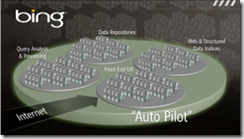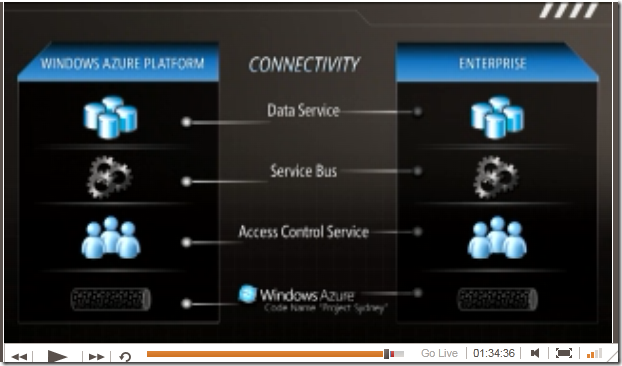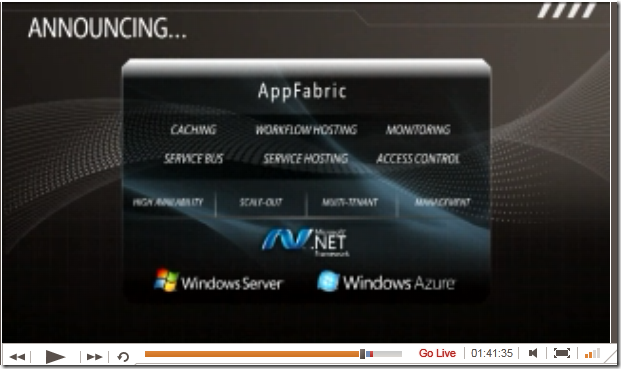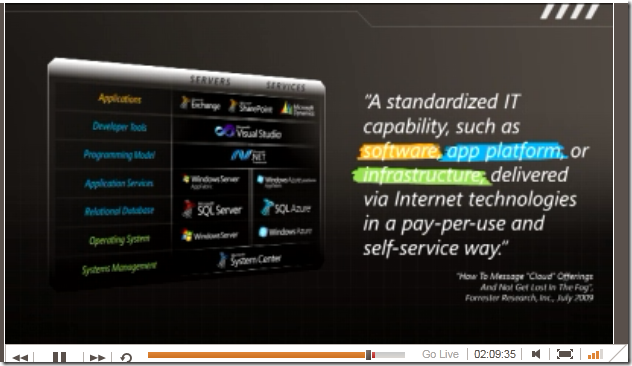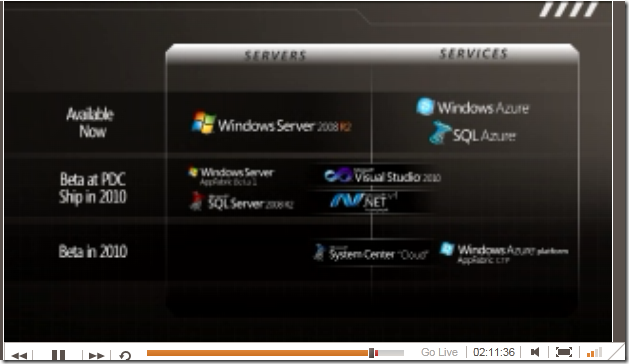My notes from PDC09 Day 1 Keynote
- Day1 is on Azure and backend services
- Day2 is on client side, Win7, IE9 and Silverlight
- The keynote can be downloaded from
http://microsoftpdc.com/Sessions/KEY01Highlights of today
- Windows Azure can now have apache, tomcat and others installed
- You can have full control of your instances, install what you want on it, then set that as your new baseline to deploy apps to
- App fabric is a new add-on for Windows Server. Lets you deploy applications to your servers easier. Also lets you easily deploy to either on premise or Azure
- Dallas CTP announce. Is a way of exposing your data feeds in an easily discoverable and consumable way http://www.microsoft.com/windowsazure/dallas/
Ray ozzie walks on stage
Ray ozzie talks about how Microsoft has been talking about Software + services for the last 4 years, last year they announced Azure.
Goes on about how everything we have is "connected", PC's, devices, etc.
They want to go towards "seamless multi screen experiences, their "3 screens & a cloud" strategy
The 3 screens are: Mobile, PC and your TV
Today we will hear more about the backend stuff. The services, azure, etc.
Tomorrow, we will hear more about front end stuff.
Software on their "3 screens and a cloud"
In tools, they have visual studio for devs. And expression studio for web
For the "3 screens"(mobile, pc, TC), they have IE + Silverlight.
Silverlight "compliments" javascript by creating highly responsive web controls
Because silverlight is .net it is the premier runtime to develop all of this software
Guy who wrote the seesmic twitter application comes on stage
Talks about how they subscribe to the "3 screens and a cloud" concept. You should be able to get your data from wherever.
They decided to write a version of seesmic using silverlight.
He is showing it using the Silverlight OOB (Out of box) experience.
They are releasing the new version today. *Edit* I installed the windows desktop version, and it is a slow non-silverlight app. Don’t know what happened here
He is saying it is very fast on Silverlight, and showing the scroll speed, etc. It does seem smoother than the bit of jerking i get when i scroll in the Adobe air version.
New features, you can click drag users between groups.
They want seesmic to be THE twitter platform. You can now create plugins for it that do lots of things. Auto tweet people, ask Mr. Tweet for more info about a person, etc.
Ray ozzie comes back
Says that tomorrow Scott Guthrie will talk about IE9. Sinofsky is talking about Silverlight 4
Starts giving the Azure marketing pitch. Made it powerful enough to scale due to all of their backend, yet familiar enough for current visual studio developers to pick it up.
The live stream glitches, then he comes back and is saying how Systems centre allows for seamless control of private clouds, etc.
Azure goes live January 1st. For all of Jan it will be free, will start charging Feb 1st.
New features that are "going live today" in Azure:
- You now have single sign on for Azure portal, Sql Azure
- They offer multiple sized VMs now (see my blog post)
- They now support much more complex service architecture (multiple worker roles, web roles)
- Support for FastCGI (PHP)
- Java running on top of TomcatThe Azure CDN datacentres are coming online
Azures datacentres are built using the "modular container" design. So they can just quickly scale up datacentres. Photos of the Azure container are at http://allyourclouds.stackexchange.com/questions/5/what-do-cloud-computing-data-centers-look-like/7#7
New storage type: Azure xdrive are Azure storage blobs that are accessible using NTFS
SQL Azure It isn't just sql server that is in VMs that are turned on.
It is a "True database as a service"
You can simply create a new database when you need it.
Don't need to think about memory, don't need to worry about replication, data recovery.
It works unmodified against Excel, .net. Is just a connection string.
Although Azure goes into production on Jan, they have allowed a few companies to go into production today. One of them is wordpress!
Founder of wordpress comes on stage
One of his devs at wordpress rang him and said "hey wordpress now supports PHP, mysql, sqlserver"
He logs onto the Azure portal and shows how he has an instance running apache. He only has 1 at the moment, says "what if we get slashdotted? Easy we just scale it up from here"
Says how the 2 most popular wordpress blogs are a "political one" and ICANHAZCHEEZBURGER
ICANHAZCHEEZBURGER guy comes on stage
Shows how he runs ICANHAZCHEEZBURGER, failblog, etc.
They don't know what is going to be popular, they have MASSIVE spikes in users due to a picture suddenly becoming popular.
They really need a way to quickly scale up and down. They don't want to have to pay during the quiet times.
Announcing a new website www.Oddlyspecific.com
They are using SQL Azure as the backend, and SQL storage for the blobs.
They have a plugin for wordpress which lets you use the Windows Azure storage platform
Means users now have more storage AND it is served over the Azure CDN!
Ray Ozzie comes back on stage
"having reliable to high scale elastic computer utility is really important"
during the windows Azure CTP, many people asked "how can I use Azure to help build my business?"
Announcing "Microsoft pinpoint"
http://www.pinpoint.com/en-US/Dallas
People wanted an easier way to find things that have already been built so that they can take advantage of it. Here you can search for solutions that already exist, experts, data feeds.
Pinpoint is integrated into the Azure portal
The most powerful place to be if you are trying to bring your services to IT pros
Online catalogues and marketplaces are useful
Announcing CTP of "Dallas" which Ray "believes to be game changing"
http://blogs.msdn.com/dallas/default.aspx
Uniform discovery way of finding data, of uniformly joining it.
Enables an open catalog and marketplace of data.
Believes it will bring in a whole new wave of "remixing"
David campbell comes on stage
Dallas lowers the barrier to finding, exploring and consuming data
Pinpoint is the place where you will find dallas data feeds.
Some are public data sources, some are commercial.
There may be ratings and reviews from people about the data
He logs in and shows how he has subscribed to 2 data feeds, one from NASA and infoUSA
Shows the full list of citysearch.com, US government
Clicks into the InfoUSA datafeed.
The data has already been described, so he can see the parameters he can put into the webform to query it (zip code, etc).
Can see the feed in Atom Pub
Clicks "analyse" and it opens up excel so he can start twisting the data.
Opens NASA feed
He can search for image scientific information, or just get the single image.
He clicks one button, and it generates a C# partial class so he can just consume it right in code!
Has a blank WPF application, he click drags a listbox on, pastes in a codesnippet to consume the data.
Shows an demo app that someone else had already written.
Is a WPF app that consumes the NASA feed and displays all the images, slideshow. Show the images using old school red/green 3D. Tells the crowd to put their 3D glasses on.
This is just a demo of what you could do if data was this easy to explore, discover and consume
Ray comes back on stage and starts a live feed with Washington DC government
Decide to democratise data
They announced health data, and encouraged everyone to use it and lots of innovation happened.
The military did the same thing, and now we have super cheap GPS. It is a great example of what can happen when data is made public.
They need to look out of the 4 walls of government and look for innovation.
http://beamartian.jpl.nasa.gov/welcome
They started off with 47 datasets. Now they have over 100,000 released datasets. Of environment hazards, of flight paths.
This data is part of the Data.gov platform
Showing an iPhone app called "career finder", shows all the government jobs available near you. App was created in only a few days
He made sure to call it a "mobile device" and not iPhone ;-)
They have a bucketload of datacentres now. The CIOs are now focused on serving up new data.
For the 1st time now, they can now focus on "service delivery" instead of worrying about infrastructure.
Live interview stops, back to Ray
When thinking of client, bet on Windows 7
When thinking of the backend, bet on Windows Azure
Think of how Pinpoint and Dallas are going to change the world with just the volume of new consumable data.
Weave together public domain data with your own data to create cool things
Shows a small vidclip.
Has "the cloud" talking about his identity crisis. He has been called a private cloud, a public cloud, he is so confused.
"YOU ARE CLOUD, embrace who you are" "embrace who you are".
WTF this is stupid.
Bob muglia comes on stage (president of server & tools)
The cloud is more than just about infrastructure
It is also about an application model. That is what he is going to talk about.
There is a lot of consistency about how they are talking about the cloud
As attributes "scale and elastic"
As things it provides "software, app platform, services"
Talks about how Bing created a controller called "auto pilot" to run all of their computers in their data centre. Automatically brought up servers to replace dead PCs
What they did was good, but it was very specific, it wasn't generalised enough to use on their other services. It was kind of a precursor to Azure.
*blah blah, the cloud is good, lets us have resources that work together. Can have ways to deploy, etc. Recaps the cloud for 5mins* Not just me, lots of people online saying "WTF is he actually talking about"
Mentions now how we can describe architecture of a cloud app which you can use to model it. Model driven approach is better.
*waffles on for another few mins*
"take steps to make your application always on, instead of down for maintenance times"
Don Box comes on stage
Last year we showed you Azure
Since then people have said that they want to use Azure to write PHP code, Java, C++
Brings up C++ in visual studio
They are going to write a CGI app, grab the query string and process it.
They are going to use pointers all over the place.
So when they hit the web app, they are going to show the 4 bytes before the query string.
Points out how there is a bug, so he puts in an asm push and pop command
They have a 2nd project, an Azure cloud project, so they are pushing it up into Azure now
Goes into the portal and publishes the Azure app ready
Moves to SQL Azure
Last year they accessed SQL Azure using REST.
Feedback was "yeah REST is great.... But we are used to connection strings and transactions and T-Sql"
They create a new SQL Azure database, now they are going to use SQL Server management studio to connect to it.
They open it up, and start executing T-SQL against it.
creates a table, starts a transaction, pastes in all the rows to insert, ends transaction
Hits execute and it immediately runs against the cloud
Last year talked about Access control Service
Enterprise grade authorisation
Feedback was "we like that... But we want something more lightweight so we can use in web pages, etc"
Worked with google, etc. To come up with a way to do it.
They use http://en.wikipedia.org/wiki/OAuth
Try to hit the data from javascript. Nope can't get in because they aren't authrorised.
So in javascript, they request a token, and can then get into it.
Kelly blue book comes on stage
They have 2 data centres, try to get one data centre serving all the customers, so they have a 2nd failover data centre.
They were paying lots for servers they didn't need... So *surprise* they moved it to Azure to reduce costs since they can elastically scale up and down.
Their data goes through ETL's and other processes, they can still use the exact same process with SQL Azure
Demoing SQL Azure Data Sync.
They can keep their on premise SQL server and the Azure one in sync. Using Azure as a backup for spikes
They have taken the time down to provision a new server down from 6 weeks to 6mins with Azure
Back to just Bob mulgia, he shows a demo reel
Dominos pizza, they have a MASSIVE spike during superbowls which is expensive to provision for.
Seiemens talking about hybrid clouds. Their on premise data centre combined with offloading to Azure
Back to bob. (1Hour, 30mins)
Access Control System is an important way of saying who has access to your services.
Sometimes you want low level access.
Announcing "project Sydney", available next year
Allows you to connect your existing apps running on your servers with Windows Azure.
Demo of it with one of their apps
They have a charity promotion called "give" which is a charity auction.
Showing it running in the IT datacentre at Microsoft (even if his URL says localhost....)
From Azure, they try to tell it to connect to his SQL server that is running on premises.
He uses the Windows Azure connectivity Agent (project Sydney) to allow "the cloud" to connect to their on premise SQL server.
Now Azure can scale and do all the compute while connecting to their existing data.
New windows Azure virtual machine role
- Select windws server base image
- Customised virtual machine role
- Snapshot virtual machine image
- Deploy app and target your new VM role
So you can preload Apache on it or whatever you want.
You can remote desktop onto it to configure it.
Announcing Windows "app fabric" (I THINK this is dublin)
Allows you to create highly scalable flexible app platform.
Built on IIS, WCF, workflow, etc. Data caching
Is an add-in for windows server
You can zip up your application, so it can be passed to your IT admins and they can publish it straight into staging. Could also send to your internet hosts and get them to deploy it. Sounds like an easier way to deploy ASP.Net applications
Windows Azure will use it, will allow for the ease of deployment between Azure and your on premise data centres.
Explanation from Mary Jo Foley: The AppFabric technology combines hosting and caching technologies (formerly known as Microsoft code-named "Dublin" and Microsoft code-named "Velocity") with the Windows Azure platform AppFabric Service Bus and AppFabric Access Control (formerly referred to as .NET Services).
New person on stage demonstrating new features in Visual studio 2010
Demoing new Visual studio 2010 features.
He runs the application, does a few things then closes it.
It shows the call trace of his app so he can see how it works (then he drags the tab to his 2nd monitor and ppl go crazy)
Showing windows federated identity. (Geneva)
AD now has an STS provider in it.
Shows how to get your app to run with authentication by just right click your solution in visual studio and using the wizard (just like adding a WCF reference)
Says his app is running slower than it should be, hitting the DB too much? So he clicks "break all" and intellisense comes up.
Filters just to show the calls to ADO.Net, then he can drill down and see where the calls were made.
Douglas purdy (Data modeling group) comes on stage (2 hours)
Opens up visual studio and an exisiting ASP.Net MVC app, windows identity services
Is going to migrate it to Azure using "models"
In VS he Creates -> New project -> application model project
Shows a blank workspace with a toolbox.
Can see "the web role", "the worker role", "the database" + more in the toolbox
To deploy the application he is going to drag out 3 roles onto the workspace
-Web role
-App fabric
-And database
Then drags the projects on top of the icons he has there for web role, database.
Can say how many instances of each he wants
He wants to just push it out into the cloud now.
Right click, "publish to test environment"
They are shredding it into oslo data modeling (which has been renamed to SQL server data modeling?)
Windows identity services is now just working, still hitting the on premise Active Directory.
Right click, generates app package.
Bundles it up into a single package. Myproject.app on the desktop
So to push it out into production, he opens up powershell
He can run "deploy-application myproject.app https://myserver -whatif"
The whatif will show what will change if he does the deployment. How many instances of each thing.
Shows Microsoft operations manager, shows it connected to Windows Azure
Can see a diagram of the application that was put into SQL server data modeling inside of operations manager. Can see the load in each of the servers for each of those roles in the diagram
They can see that the server in Azure is overloaded, so they tell it to scale up from 2 to 4 from inside Operations manager.
They expand that web role for the ASP.net app, they can see the 2 existing servers and the 2 that are spinning up.
Bob back on stage
Says "see, this is why i was talking about the importance of modelling".
talks about how all of this is in the new server / services stack.
Keynote closes
